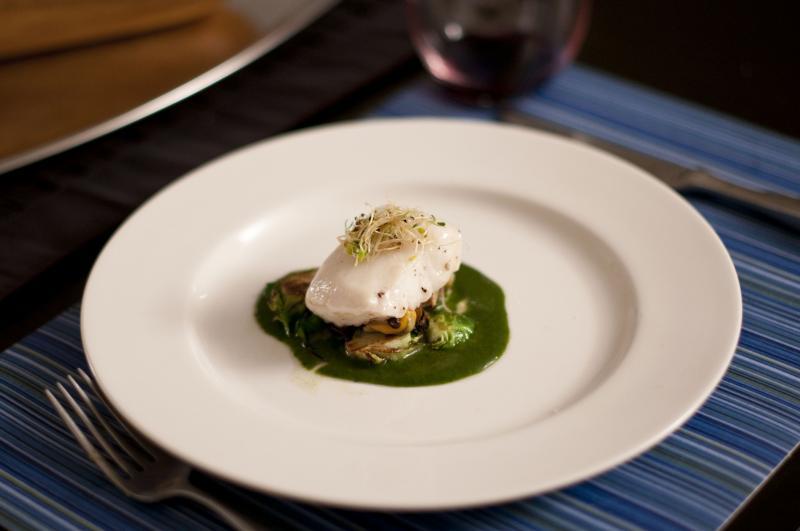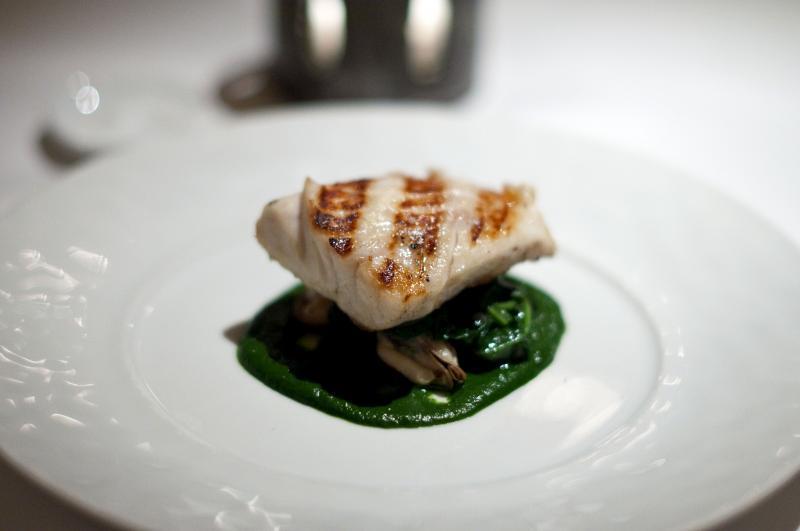-
Posts
164 -
Joined
-
Last visited
Contact Methods
-
Website URL
http://
Profile Information
-
Location
Minneapolis
Recent Profile Visitors
1,872 profile views
-
Just another SV exercise - flank steak/ Atlantic halibut. I got an inspiration from a dish by Chef Gustav Ottenberg form Leijontornet restaurant restaurant in Stockholm, Sweden ( described and pictured on pp. 280-281 in the new COCO book): Flank Steak, Pickled Pearl Onions, Onion Puree, Grean Beans, Yellow Mustard Seed Flank steak was season with kosher salt, black pepper and kebbeh spices, vacuum-packed and cooked to medium-rare at 64C for about 2 hours ( for presentation purposes I decided to cook the entire steak and slice it just prior to service). Also, same dinner - different dish: Atlantic halibut poached in extra virgin olive oil, Prince Edward Island mussels, Brussel sprouts, Chinese broccoli and Black Garlic sauce, microgreens: This dish is inspired by similar plate at Gramercy Tavern in NYC. Halibut was poached in a vacuum bag with EVOO, fenugreek and saffron @ 59C for about 15 minutes (tecture was fall-apart tender, but not at all mushy), mussels were steamed with herbs, Brussel sprouts were caramelized with butter, Chinese Brocolli puree was thickened with light brown roux. I absolutely love the 57-59C range for white fish - great and consistent results. Just for comparison - please look at the original dish: I would be happy to answer questions, if any.
-
There are quite a few points that I would like to cover with regards to internal (core) temps and degrees of beef doneness , however for right now may I suggest a link with pictures from Certified Angus Beef ® Degrees of Doneness Few quick notes: ... I find that in order to get anything cooked SV which resembles rare steak cooked conventionally I cannot exceed a core temperature of 48C/49C. At 54C any beef I've cooked is what I would call medium - i.e. uniformly pink throughout with no red/raw appearance at all. Cooking at any temp higher than 54C the beef starts to lose it's pinkness and becomes increasingly grey as the temperature is increased. For me any "greyness" at all starts to get into what I describe as well done. Cheers, Peter. ← This is critical: Whether we apply conventional cooking technique, or cook our steaks SV the goal is to achieve right internal (core) temperature for a desired degree of doneness. Needless to say, SV allows to achieve much more precise internal temperature, as well as allows to do it with ease. However, temperature points of doneness are identical for proteins cooked conventionally, and for the same proteins cooked SV. I would also like to ask any of you to support your statements about degrees of beef doneness with appropriate pictures, please.
-
Robert, 15 minutes would most certainly be not enough time for a large cut like whole prime rib, and I would have give it another 5-10 minutes for a rib-eye steak. However, cap of the rib-eye is a relatively thin muscle, so I cook it just like I would cook tenderloin, as far as time/temp are concerned. I have to ask you for clarification of what you mean by "starting temperature" - I start and finish SV at precisely the same temperature, depending on how I want my protein cooked ( generally speaking: 54-56C for fish, 61-64C for steaks) There is no benefit of having a cooking bag in the bath as it being warmed up, if that's what you are asking. 61C is internal temperature for any steak done rare, 62-63C - medium rare, 64C - medium. 55.5C would be undercooked by any standards. Typically, I flash sear my steaks in very hot clarified butter ( 5-10 sec. on each side) after poaching, immediately prior to serving.
-
[Moderator note: The original Sous Vide: Recipes, Techniques & Equipment topic became too large for our servers to handle efficiently, so we've divided it up; the preceding part of this discussion is here: Sous Vide: Recipes, Techniques & Equipment (Part 5)] This weekend I've cooked with two somewhat non-traditional cuts of meat: Lamb Tenderloin: - Slow Baked Beets, Compressed Aian Pear and Microgreens, Red Wine Jus ("Sauce au Poivre") The tenderloin was sous-vide with kubbeh spices @ 63C, for about 20 minutes Cap of the Ribeye: This is a pretty straight-forward dish - cap of a prime rib ( "lifter meat") sous-vide to rare with simple seasoning, 61C for about 15 minutes Both cuts truly shine when SV technique is applied.
-
Peter, More in agreement with you I can not be - there is a lot work/research to be done. Personally, I rely on empiric evidence ( and trial and error, as its integral part) rather than theoretical projections by even the greatest minds out there. In conclusion, I would like to show you a picture of short ribs cooked SV: Short Ribs were cooked at 88C for 6 hours - wonderful texture. ( this plate was inspired by Alinea recipe)
-
Thanks, e_monster, That is the point that I am trying to make. We have people form different countries (and different kitchens), so sometimes definitions get blurred. I like this source: Meat Buyers Guide It's an expensive book, but one can "Look Inside!" on amazon.com. Just for reference: Flat Iron is described on p. 18, cut number 114D.
-
I took a liberty to compare cooking times for Lamb Loin, as per several different sources: Achatz: 20 minutes @ 57C / Core temp - not specified Keller*: 35 minutes @ 60.5C / Core temp - not specified Roca: 20 minutes @ 65C / Core temp - 60C Stampfer: 25-30 minutes @ 66C / Core temp - 64C (* - Keller suggests the time and temps for lamb saddle - loin and tenderloin connected by transglutaminase) I chose Lamb Loin for this illustration primarily because all four authors described cooking that particular cut SV. Should anyone be interested, I would be happy to illustrate suggested temps for tenderloin, and/or braised cuts. I would like to point out that the sources quoted come from four different, professional and accomplished chefs, as such their recommendations, in my opinion should not be ignored.
-
OK, I am back home, so please find the reference: Sous-Vide: Garen Im Vakuum Viktor Stampfer 2009 Matthaes Verlag GmbH, Stuttgart ISBN-10: 3875150279 ISBN-13: 978-3875150278 "The correct temperature for cooking sous-vide" Chapter by Bruno Goussault pp.14-15 Noteworthy, the author cites microbiological studies performed at CREA.
-
.... Tri-tip, flat-iron steak and chuck are cuts that are flavorful but not tender. If you cook chuck to medium-rare as you would a ribeye, you will have a tired jaw by the time you finish eating. Despite having the word 'steak' in its name, chuck "steak" is a tough cut that in my opinion benefits from the tenderizing effects of temperature over extended periods of time. The amount of tenderizing depends on how tough the cut it. Flat-iron steak cooked for 24 hours (per Doug Baldwin's suggestion) has to my taste a really nice texture that it doesn't have when it is pan fried as one might cook a more tender cut like filet or ribeye. ..... ← It's hard to argue personal taste matters - flat-iron steaks to me do not need additional tenderizing, but it's clearly a matter of individual preference.
-
Dear Robert, First and foremost - I hope we never have to deal with the latter scenario. Secondly, microbiology is an integral ( and lengthy) part of MedSchool curriculum, and as such, I hope, deserves at least some of your respect. I am away form home right now, but I will make the sources and studies available to you very shortly. That said - are we trying to share SV cooking experience and tips, and make our food taste better? As such, and I base that statement on daily SV cooking experience: there is no advantage to cooking a steak for 24 hours - it's simply unnecessary, for the reasons I described above. However, if you come across a published recipe by a professional Chef in the course of your independent evaluation - please post it, it would be interesting to try it.
-
Dear Peter, Thank you for your reply. For the record, I truly respect the work and research by both nathanm and Douglas Baldwin. Also, I wouldn't go as far as as universally rejecting all low temp/long time advice - there are certain applications that from my standpoint are perfectly acceptable. That said, my approach to SV is primarily utilitarian - I routinely ( in fact - daily) apply SV in my cooking, mostly for proteins and use it because of the qulity, texture and most important - taste of final product. Also, I have enormous respect for Chef Keller, and would take his kitchen-tested and well proven instructions over even the most accurate hypothetical calculations. The point of cooking a steak-type cut SV, in my opinion is to achieve perfectly uniform temperature ( i.e. degree of doneness) throughout the protein, and, as a consequence to avoid overcooking. Why cook a steak for 24 hours , when all one needs is 20-30 minutes of SV cooking in a medium (water) just a few degrees warmer? "Steak" cuts do not have a lot of collagen we need dissolved, unlike short ribs or shanks, nor there is abundant fat to be rendered out. You mentioned you are planning to cook for your family - personally, I would do for my family ( esp. if there are children involved) exactly what Chef Keller does for his guests, and avoid a risk of anaerobic contamination ( to which, again, children are more susceptible) altogether. There are many participants in this thread, and there are many opinions - all of which deserve respect. My suggestions to you are based on first-hand SV experience and common industry standards, but whether to accept those is your individual choice, of course.
-
Dear Robert , If I may - I would strongly discourage you from cooking flat-iron steak the way you have described, and for several reasons. First, flat-iron is a steak cut, and as such it simply does not need that long of a cooking time, just like fillet mingnon does not need to be braised in conventional cooking; Secondly, you are about to put a piece of protein in a vacuum bag at 55C/131F, and bathe it for 24 hours, essentially creating a perfect medium for harmful anaerobic bacteria ( Thomas Keller in "Under Pressure" specifies that any protein held at temps below 60C for longer than 4 hours is to be discarded, as it is presumed contaminated - more in agreement I can not be, both as a physician, and as a cook). My suggestion is to cook flat-iron steaks at desired temp/doneness ( my preference is medium rare @61-63C), for about 20-45 minutes, depending on the thickness, and flash brown the steaks in clarified butter, just prior to service.
-
Dear Dr., The Vanilla Mousseline this recipe is essentially Bearnaise with vanilla - I would be happy to give you a recipe and detailed technique, if you are interested. Personally, I do not see a compelling reason to use sous-vide in Hollandaise-based sauce preparation, or to even hold the said sauces, however, in Creme Anglaise recipe /"Under Pressure" (p.252) Thomas Keller recommends dropping a bag with whipped yolks in 85C bath, reducing temp to 82C and cooking it for 20 minutes. If I may make a suggestion: adding a touch of xanthan gum would considerably extend holding time of any Hollandaise-based sauce in either home or a restaurant kitchen.
-
One of my absolute SV favorites is shellfish. Recently, I have made two dishes utilizing squid and lobster. Salad of Squid and Hearts of Palm - Atlantic Squid, Fresh Hawaiian Hearts of Palm, Asian Pear, Squid Ink Sauce, Pepper Confetti, Mizuna Garnish. This one is straight from "Under Pressure": I have reservations about saying that this dish is inspired by Thomas Keller, rather it's [almost] exact replica of a plate described and pictured in the "Under Pressure" Fish and Shellfish chapter. However, I added a few touches of my own, and replaced suggested nectarines with Asian Pears. Squid was cleaned, sliced in ribbons, and cooked sous-vide @65C for 10 hours with thyme, rosemary, coriander, cumin, alspice, ginger and chilies. Original recipe does not suggest alspice and ginger, but I felt it'd be a nice addition. Fresh hearts of Palm were sliced on a mandoline, pepper confetti was made from sweet baby red, orange and yellow peppers, squid ink sauce made with fresh squid ink, canola oil, mustard an yuzu - the latter being added instead of lemon oil Chef Keller used in his original recipe. This is a very fresh, refreshing plate, albeit and perhaps not quite as refined as one would expect from Chef Keller, but it takes advantage of extremely fresh and unique ingredients, and capitalizes on the use of sous-vide texture of squid. The second plate was a bit more of a free-style approach: "Lobster and Squash, Vanilla Mousseline" - I got the idea during my lunch at "Per Se" Overall, it worked - I especially enjoyed making the "vanilla mousseline". Unfortunately, I was not able to find any red-fleshed squash - which basically ruined the dish for me. Lobster was cooked sous-vide at 59.5C with sweet cream butter, tarragon and spices - quite good. Please see additional pictures on flickr
-
Ruth, It was Maple Leaf FarmsPeking Duck breast with skin on and it was not falling apart tender, but rather had a nice bite to it.






